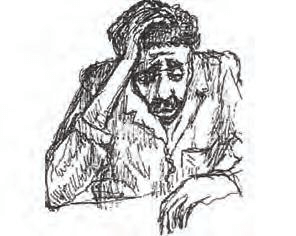
For nearly 2,500 years, mood disorders have been described as one of the most common illnesses of humankind, but only recently have they commanded major public health interest. The World Health Organization (WHO) has ranked depression fourth in a list of the most urgent health problems worldwide. Depressive disorder affects one out of five women & one out of ten men during their lives. People affected by mood disorders are at high risk for suicide & no less than 15% of them completed suicide. Furthermore, many people with mood disorders are disabled. Thus, mood disorders are truly public health problems.
Mood disorder can be classified as low mood (depression) or high mood (mania).
Depression, a mental illness characterised by low mood (sad mood), is one of the most serious and common mental disorders. In your practice you will see many people with depression: as many as 1 in every 10 adults and possibly 1 in every 30 children. It is normally easy to identify people with depression in your community. However, it is important to realise that low mood is also part of a normal human experience, and fortunately in most people low mood does not develop into a serious depression. When a person is depressed, the person has feelings of sadness that are excessive for the situation that has brought them on or the sadness lasts for an unusually long time.
These feelings are so severe that they interfere with daily life. Depression is important because it affects many people and causes a high level of distress. It impairs a person's ability to deal with day-to-day problems or to carry out their responsibilities. People with depression have increased risk of death from suicide and from other physical conditions.
Depression is also important because it is often under-recognized but can be treated. About 15% of people in the world will have an episode of severe depression at some point in their lives. Women are more likely to develop depression although this has not been confirmed in Ethiopia. Depression can affect people of all standing and of any age, including children. A depressed person often loses interest in things that they used to enjoy or like. Depression can cause a wide variety of physical, psychological (mental) and social symptoms.
Signs and symptoms of depression:

Grief and depression
Grief and depression share similar characteristics; however, there are important differences between the two. Grief is a natural response to a loss and depression is an illness. But it can sometimes be hard to distinguish between the two. An important distinction is that people who are grieving are still able to enjoy things and can look forward to the future. But those with depression tend to have constant feelings of sadness and have little enjoyment or positive expectations of the future.
Postnatal period depression
The first two months after childbirth are associated with increased risk of depression. The most common condition is called postnatal blues, which is a mild and transient depression occurring in the first five days after the child is born in about 50% of mothers. The mother feels easily upset, tearful and less confident about herself and her role. Support and reassurance from husband and familyares sufficient. Some simple traditional practices that give a sense of security, such as keeping a metallic item under the pillow, and practices indicative of support from husband and family, are also important. But the blues can progress into more severe depression.
How to assess a person with depression?
For a variety of reason, it may sometimes be difficult to assess a person with depression. The person may not know that they are depressed and ma, therefore, be unlikely to tell you about their low mood.Instead,d they will often complain about physical symptoms, such asa headachee and back pain. They may not feel like talking, and you may feel pushed away by them. Some patients with depression are easily annoyed or irritabl, and you may find it difficult to talk to them. Finally, they may be feeling that nothing is going to help them and may think it is pointless to talk about their problems. These are only examples of the potential barriers for assessing depression.
Whenever you suspect that someone might have depression, ask directly about their mood. A person is very unlikely to be upset if you ask them directly if they have been feeling low or depressed. When you see a person who you think may have depression, just talk to the person in a natural way, listening to their problems and difficulties. This will give you the opportunity to understand the kinds of problems the person may be having as well as to explore their emotions. The questions you ask and the emphasis are likely to vary from person to person, but there are general and specific questions that you can use to screen for depression. Some simple questions that you can use are:
Management of a patient with depression
What to tell the person and their family about depression?
Reassure them:
Referring a person with possible depression
Urgent referral is required if the person:
Complications of depression:
The main complication of depression is death from suicide. Up to 15% of individuals with severe depression (about 1 in 7) will die from suicide unless they are properly treated and followed up. Additionally, those with depression are more likely to develop other medical problems such as hypertension, other heart conditions, diabetes mellitus or infectious conditions.
Mania or high mood is a type of severe mental illness characterized by a distinct period of abnormally and persistently elevated, expansive, or irritable mood.
Signs and symptoms of Mania